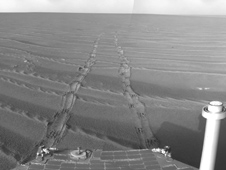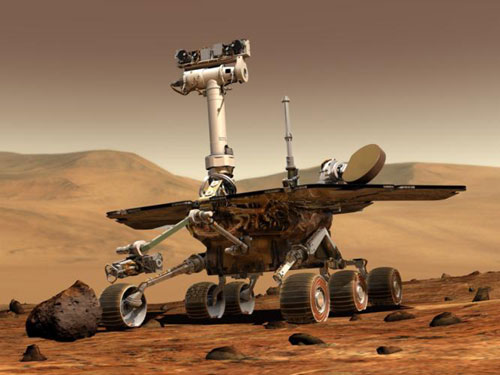Spirit is a little faltering, and this fact has also been used for scientific discoveries, while Opportunity is put through an obstacle course

NASA's Spirit and Opportunity rovers may have more big accomplishments as they enter the fifth anniversary of their fondly remembered Mars landing.
Among the hundreds of engineers and scientists who cheered at NASA's Jet Propulsion Laboratory (JPL) in California on January 3, 2004, when Spirit landed safely and 21 days later when Opportunity followed, no one expected that the crew would continue to operate both robots in 2009 .
"The American taxpayer has been told that the mission is scheduled to continue for three months," said Ed Weiler, NASA's assistant administrator for science space missions at NASA Headquarters in Washington. "The twin vehicles have been working for 20 times longer. This is a huge return on income in these tight budget times.
The vehicles have made important discoveries about the violent and wet environments on ancient Mars. They also transmitted about a quarter of a million images, traveled more than 21 kilometers together, climbed a mountain, descended into craters, battled sand traps and aging hardware, survived dust storms, and transmitted more than 36 gigabytes of data using the Odyssey satellite. So far, the vehicles are ready for new promotions and the team has plans for them.
"These vehicles hold up quite well considering the extreme environment the systems experience every day." said John Callas, Spirit and Opportunity's project manager. "We understand that an important component of one of the vehicles may fail at any moment, ending the mission without prior notice, but on the other hand, we can complete covering a distance 4 times larger than the planned design for each vehicle in the coming year."
Random cleaning of the dust from the solar collectors by the winds blowing on Mars, provided unexpected assistance in extending the life of the vehicles. However, this is help that cannot be trusted. Spirit has not had a good cleaning in over 18 months. The dust-covered solar panels provide barely enough electricity to allow the car to survive its third southern hemisphere winter, which ends in December. "It was a creaking winter for the spirit," said Kalas. "But we managed to get through it."

When Spirit's energy production increases in the spring and summer, crew members plan to drive the vehicle to a pair of targets located about 180 meters south of its site where it spent most of 2008. One of them may provide support for the hypothesis that the plane Spirit has been exploring since 2006, known as the home plane , is a remnant of a much larger piece of lava plane. The second site is a pit several meters deep known as Goddard. "Goddard does not appear to be an impact crater," says Steven Squires of Cornell University in Ithaca, New York. Squires is the chief researcher of the scientific instruments on the vehicles. "We suspect that this may be a crater created by a volcanic explosion, and that this is something we have not seen so far."
A light-colored ring around the interior of the pit may add information about the bright spot containing iron-rich soil that Squires counts among Spirit's most important discoveries to date. Spirit discovered the formal land in mid-2007 thanks to a glitch - Wheel towing which the vehicle has been following since the beginning of 2006. The silica was almost certainly formed at a time when it erupted in a kind of hot spot or because of the flow of water in the area.
For Opportunity, the next big target is Endeavor Crater Which is about 22 kilometers in diameter, 20 times larger than the Victoria impact crater that Opportunity spent most of the time in the last two years. Although Endeavor is 12 kilometers from Victoria, it is a long distance for vehicles, the road is full of bumps.
since climbed Opportunity out of Victoria Crater About four months ago, the Gamma vehicle was nearly 2 kilometers into its path toward Endeavour, and stopped to examine for the first time loose rocks that the team plans to examine along the way. High-resolution images taken by the Mars Rover MRO spacecraft, which arrived at Mars in March 2006, are helping the crew plot a path that will bypass potential sand traps that were previously indistinguishable from orbit.
"We continue to raise the bar in terms of what the vehicles are capable of doing," said Frank Herman, JPL vehicle driver. "At one time driving Opportunity to Endeavor was considered a crazy idea, but now we're making it happen."
And Squires adds: "The expeditions were motivated by scientific reasons, but led to something else important. They became humanity's first exploration of another planet. When people look back on this period in a few decades, Spirit and Opportunity will be remembered not for their scientific achievements, but because it was the first time we went to explore the surface of Mars."

4 תגובות
;
I keep hearing about the dust that accumulates on the receptors, and in the end disables the vehicle, and I don't understand what the problem is to install and direct them to operate from time to time and clean the dust. What the hell is the problem with installing directly? Why can't the great NASA invent a self-cleaning mechanism?
I also follow on a daily basis and this is a fascinating story.
As someone who has been following this journey for a long time I have to admit it is a fire starter
the imagination and exciting.